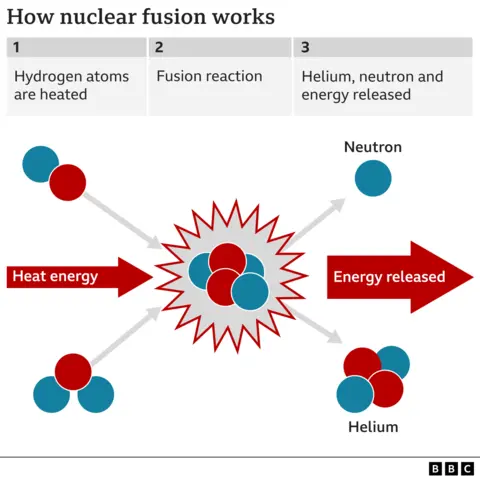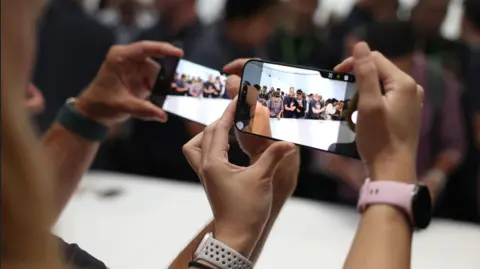Sci-Tech
India’s wildly popular payments system attracts scammers

By Priti Gupta, Technology Reporter
 Arun Kumar
Arun KumarEvery day, for the last seven years, Arun Kumar has set up his fruit stall on a busy Mumbai street.
It’s not an easy way to make a living.
“Being a street vendor is a challenge. There’s the fear of being robbed or, as I am not a licensed vendor, the local body can come and dismantle my store anytime,” he says.
But over the past four years at least one aspect of his work has become easier.
“Prior to Covid everything was in cash. But now everyone pays with UPI. Scan the code and the payment is done within seconds.
“No issues of handling cash, giving change to customers. It has made my life and business smooth,” he says.
UPI, or to give it its full name the Unified Payments Interface, was launched in 2016 in a collaboration between India’s central bank and the nation’s banking industry.
It’s an app-based instant payment system, which allows users to send and receive money, pay bills and authorise payments in a single step – no need to enter bank details or any other personal information. And, perhaps most importantly, it’s free.
It has become so popular that India is now the biggest real-time payments market.
In May, UPI recorded 14 billion transactions, up from nine billion the year before.
 Getty Images
Getty ImagesBut the popularity and ease of use has made it a rich feeding ground for scammers.
“While digital payments are convenient, they do come with vulnerabilities,” says Shashank Shekhar, founder of the Delhi-based Future Crime Research Foundation.
Mr Shekhar says that scammers use a variety of ways to trick people, including persuading them to share their UPI pin number, which is needed to authorise payments.
Some scammers have also created fake UPI apps, that are clones of legitimate banking apps, and then steal login details or other valuable information.
“The pace at which digital transformation took place in the country means unfortunately digital literacy and safe internet practice could not catch up,” says Mr Shekhar.
He says that between January 2020 and June 2023 almost half of all financial fraud involved the use of the UPI system.
According to government figures there were more than 95,000 cases of fraud involving UPI in the financial year ending April 2023, up from 77,000 in the previous year.
Shivkali was one such victim. She had always wanted to own a scooter, but they were beyond her budget.
However, earlier in the year the 22-year-old, who lives in Bihar state in northeastern India, spotted one for sale on Facebook that looked like a great deal.
“I grabbed the opportunity without thinking,” she says.
A couple of clicks later and she was talking to the owner, who said that for $23 he would send over the vehicle papers.
That went smoothly, so Shivkali continued to send the owner money, via instant transfers. She eventually ended up paying $200, but the scooter (also commonly called a Scooty in India), was never delivered.
Shivkali realised she had been scammed.
“I did not think I could be cheated, as I have some education background and know what is happing in the world. But scammers are smart. They have an art of speaking to convince the opposite person,” she says.
The government and the central bank are looking at ways to protect UPI users from scammers.
But at the moment, if a victim wants compensation, they have to approach their bank.
“The problem is deep rooted,” says Dr Durgesh Pandey, an expert in financial crime.
“Most of the onus lies with banks and telecom companies. They are lax in making identity checks, that’s why the fraudster can’t be traced.
“But the challenge for banks particularly is that they have to balance between inclusivity, ease of business and enforcement of identity checks. If they are too rigid, the vulnerable section of society will remain without banking facilities.”
But Dr Pandey argues that in most cases of fraud, the bank is not totally to blame.
“It’s a complex question because the problem lies with banks, but it’s the victim who is giving his credentials in most case. I would say both victim and bank should bear the loss.”
 Poonam Untwal
Poonam Untwal Despite those problems, UPI is being promoted in rural areas where access to banking services can be difficult.
Poonam Untwal from Rajasthan runs a guidance centre which helps people use the internet and digital banking.
“Most of us are not that educated, nor know the proper use of smartphones. I teach them that phones are no longer a device just to talk to people but banks at their fingertips,” she says.
She believes that UPI will help develop the local economy.
“Many women like me have a small business that we run from our home. Now we can receive and send money with UPI. People who don’t have smart phones come to my centre to get their transactions done,” she says.
As well as making inroads into rural areas, UPI is spreading overseas.
Retailers in Bhutan, Mauritius, Nepal, Singapore, Sri Lanka and UAE will take UPI payments.
And this year, France become the first European country to accept UPI payments, starting with tickets to the Eiffel Tower.
Back in Mumbai, Mr Kumar is happy that he no longer has to use cash, but remains wary.
If he can’t get a good internet connection then customers can, by accident or design, make off without paying.
“For a small vendor like me it [UPI] made receiving money very easy. But I am always scared of fraud. I keep hearing in the news how the UPI frauds are increasing. Hopefully some mechanisms are invented so a small vendor like me doesn’t face losses.”
Sci-Tech
Could powerful lasers power a working reactor?

 Damien Jemison
Damien JemisonDeep under the Nevada desert in the 1980s the US conducted secret nuclear weapons research.
Among the experiments was an effort to see if nuclear fusion, the reaction which powers the sun, could be sparked on earth in a controlled setting.
The experiments were classified, but it was widely known among physicists that the results had been promising.
That knowledge caught the attention of two young graduate students working at the Los Alamos National Laboratory in the late 2000s, Conner Galloway and Alexander Valys.
The Los Alamos lab was originally set up in 1943 as a top-secret site to develop the first nuclear weapons. Located near Santa Fe, New Mexico it is now a US government research and development facility.
“When Alex and I learned about those tests at Los Alamos, our reaction was like ‘wow, inertial fusion has already worked!’. Laboratory-scale pellets were ignited, the details were classified, but enough was made public that we knew that ignition was achieved,” says Mr Galloway.
Nuclear fusion is the process of fusing hydrogen nuclei together, which produces immense amounts of energy. The reaction creates helium and not the long-lived radioactive waste of the fission process which is used in existing nuclear power stations.
If fusion can be harnessed, then it promises abundant electricity, generated without producing CO2.
Those tests in the 1980s led to the US government building the National Ignition Facility (NIF) in California, a project to see if nuclear fuel pellets could be ignited using a powerful laser.
After more than a decade of work, in late 2022 researchers at NIF made a breakthrough. Scientists conducted the first controlled fusion experiment to produce more energy from the reaction than that supplied by the lasers which sparked it.

While physicists around the world marvelled at that breakthrough, it had taken the scientists at NIF much longer than expected.
“They were energy starved,” says Mr Galloway.
He doesn’t mean they needed more snacks, instead the NIF laser was only just powerful enough to ignite the fuel pellet.
Mr Galloway and Mr Valys think that more powerful lasers will make it possible to build a working fusion reaction that can supply electricity to the power grid. To do that they founded Xcimer, based in Denver.
NIF had to make do with a laser that could pump out two megajoules of energy. Mr Galloway and Mr Valys are planning to experiment with lasers that can supply up to 20 megajoules of energy.
“We think 10 to 12 [megajoules] is the sweet spot for a commercial power plant,” says Mr Galloway.
Such a laser beam would hit the fuel capsule with a powerful punch. It would be like taking the energy of a 40-tonne articulated lorry travelling at 60mph and focussing it on the centimetre-sized capsule for a few billionths of a second.
More powerful lasers will allow Xcimer to use larger and simpler fuel capsules than NIF, which found it difficult to perfect them.
 Xcimer
XcimerXcimer joins dozens of other organisations around the world trying to build a working fusion reactor.
There are two main approaches. Smashing a fuel pellet with lasers falls under the category of inertial confinement fusion.
The other way, known as magnetic confinement fusion, uses powerful magnets to trap a burning cloud of atoms called plasma.
Both approaches have daunting engineering challenges to overcome.
In particular, how do you extract the heat generated during fusion so you can do something useful with it, like drive a turbine to make electricity?
“I suppose my scepticism is, I haven’t yet even seen a persuasive conceptual diagram of how you manage the process of taking energy out while keeping the fusion reaction going,” says Prof Ian Lowe at Griffith University in Australia.
He has spent his long career working in energy research and policy. While Prof Lowe supports the development of fusion technology, he just argues that a working fusion reactor won’t come fast enough to help bring down CO2 emissions and tackle climate change.
“My concern is that even the most optimistic view is that we’d be lucky to have commercial fusion reactors by 2050. And long before then we need to have decarbonized the energy supply if we’re not going to melt the planet,” he says.
Another challenge is that the fusion reaction produces high energy particles that will degrade steel, or any other material that lines the reactor core.
 Getty Images
Getty ImagesThose in the fusion industry don’t deny the engineering challenges, but feel they can be overcome.
Xcimer plans to use a “waterfall” of molten salt flowing around the fusion reaction to absorb the heat.
The founders are confident that they can fire the lasers and replace the fuel capsules (one every two seconds) while keeping that flow going.
The flow of molten salt will also be thick enough to absorb high energy particles that could potentially damage the reactor.
“We just have two relatively small laser beams coming in from either side [of the fuel pellet]. So you only need a gap in the flow big enough for those beams, and so you don’t have to turn off and turn on the entire flow,” says Mr Valys.
But how quickly can them make such a system work?
Xcimer plans to experiment with the lasers for two years, before building a target chamber, where they can target the fuel pellets.
The final stage would be the working reactor, which they hope would be plugged into the electricity grid in the mid-2030s.
To fund the first phase of their work, Xcimer has raised $100m (£77m) . The money will be used to build a facility in Denver and the prototype laser system.
Hundreds of millions dollars more will be needed to build a working reactor.
But for the founders of Xcimer, and other fusion start-ups, the prospect of cheap, carbon-free electricity is irresistible.
“You know, it’ll change the trajectory of what’s possible for humanity’s progress,” says Mr Valys.
Sci-Tech
Apple banks on AI to boost sales of its new iPhone

 Getty Images
Getty ImagesWith business slumping, Apple has been under pressure to show what it will offer buyers to jumpstart a new wave of iPhone sales.
On Monday, the technology giant revealed its hand – the iPhone 16 which has a camera button on the outside of the handset.
The button is an external clue to the changes Apple said it had made inside its latest smartphone, aimed at harnessing the latest in artificial intelligence (AI).
Apple’s chief executive Tim Cook said the upgrades would “push the boundaries of what a smartphone can do” but the firm has tough competition, as other brands have already integrated generative AI features into their handsets.
Apple’s share price fell during its “Glowtime” event, where it unveiled the iPhone 16 as well as other products, and ended the day flat. The company, worth $3 trillion, is facing concern that it is losing its edge in the burgeoning area of artificial intelligence.
Sales of the iPhone – Apple’s most important product which accounts for around half of its total sales – have stalled in recent months. They slipped by 1% over the nine months ended 29 June compared with a year earlier.
Apple said its new phones, which come with longer lasting batteries, more powerful chips and enhanced privacy features, were its first built specifically to handle AI and its new “Apple Intelligence” tools, many of which were announced in June.
Those include new tools for writing and creating new emojis as well incorporating OpenAI’s chatbot ChatGPT into Siri to help users with some queries and text generation requests.
On Monday, Apple also announced updates to its Apple Watch and its AirPod headphones, which will allow them to automatically drop the volume when users start in-person conversations and to decline calls with the shake of a head.
It said the Pro version of its AirPods would be able to be used as a “clinical grade” personal hearing aid for people with mild or moderate hearing loss.
The company said it was expecting marketing approval from regulators for the device “soon” and the feature would be available this autumn in more than 100 countries, including the US, Germany and Japan.
Previously, the company had a feature that allowed people to pair hearing aids with iPhones and other devices.
The products were rolled out at a glossy event where protestors gathered in a designated free speech area across the street, urging executives to ramp up efforts to protect children from dangerous content in the company’s App Store.
The protest featured a life-sized blow-up made to resemble Mr Cook.
Sales of the new range start in September, with prices for the iPhone16 starting at $799.
But the Apple Intelligence features are not set to be available on operating systems until October, starting in the US and heading to other countries in the following months. They will be available in the UK in December.
Ben Wood, chief analyst at the market research firm CCS Insight, said it was likely that many people would dismiss the company’s new camera control as a “glorified shutter button”.
But he said it offered “very significant” upgrades, including visual, AI-powered search and he came away from the presentation persuaded that Apple would win over customers.
“The combination of Apple Intelligence and new camera features on the iPhone 16 will help spur upgrades from loyal Apple customers,” he said. “Particularly as Apple is positioning this latest update as being a future-proof purchase for customers wanting to get Apple Intelligence features as they roll out over the next few years.”
 EPA
EPAApple has been slower than rivals Samsung and Google to bake generative AI features for photo editing, translation and web browsing into its devices.
Competitors are now building them into folding, flipping and even tri-folding smartphones.
Pre-orders for Huawei’s new tri-fold phone, the Mate XT, reportedly hit more than three million on Monday.
Gartner analyst Annette Zimmermann said because Apple was rolling out AI-ready smartphones later than rivals, it was “critical” they deliver.
She warned that rolling the features out before they were ready could risk their reputation or prompt sales losses.
Sci-Tech
Google’s lucrative ad tech business goes on trial

The US government is taking aim at the engine of Google’s immense wealth – its extremely lucrative ad tech business.
A trial beginning on Monday will hear the Department of Justice’s case that the search engine’s parent company Alphabet illegally operates a monopoly in the market.
The company earned more than $200 billion (£152bn) last year through the placing and selling of ads seen by internet users.
Alphabet has argued its success is due to the “effectiveness” of its services – but prosecutors say it has used its market dominance to stifle rivals.
“It is a really important industry that grabs billions of consumer dollars every year,” said Laura Phillips-Sawyer, a professor at the University of Georgia School of Law.
“I think all consumers have an interest in this litigation.”
It is the second major antitrust case the tech giant has faced in the US.
In August a judge ruled its dominance of search was illegal, with the penalties Google and Alphabet will face as a result of that decision so far unclear.
According to the lawsuit filed by the Department of Justice (DoJ) and a coalition of states in 2023, Google dominates the digital ad marketplace and has leveraged its market power to stifle innovation and competition.
Google meanwhile contends it is just one of several hundred companies that facilitate the placement of digital ads in front of consumers.
It argues that competition in the digital ad space is growing, not contracting – citing increased ad growth and revenues for companies such as Apple, Amazon and TikTok as proof in a blog post responding to the DoJ’s lawsuit in 2023.
Both sides will present their cases to US District Judge Leonie Brinkema, who is expected to deliver a verdict.
The bench trial comes on the heels of a landmark decision last month in a different monopoly case brought by the Justice Department against Google.
Judge Amit Mehta ruled that Google acted illegally to squelch competition in its online search business.
“Google is a monopolist, and it has acted as one to maintain its monopoly,” he wrote.
During last year’s trial, Google said it dominated online search because it had a better product.
And the company is seemingly deploying a similar defence in the ad tech case.
When asked for a statement, it referred the BBC to its 2023 blog post, in which it states that “no-one is forced to use our advertising technologies – they choose to use them because they’re effective.”
Judge Mehta held a status conference on Friday as he begins the process of deciding on remedies for Google’s conduct.
“The DoJ clearly had a big win, and they’re going to ride that momentum,” Dan Ives, managing director at Wedbush Securities, told the BBC.
He said he expects those remedies to involve “business model tweaks, not a breakup” of the company.
Meanwhile, in Justice Brinkema’s courtroom, the arcane process that governs advertising technology could make the DoJ’s attempts to prove its case an uphill climb.
“We all use search. We all intuitively understand that product,” said Rebecca Haw Allensworth, an antitrust professor at Vanderbilt University Law School.
By comparison, advertising technology is “so complex that I think that’s going to be a real challenge for the government to make a clear, simple monopolisation argument here.”
The US is not the only country where regulators are unhappy with Google’s ad tech business.
On Friday, the UK Competition and Markets Authority said it believed Google was abusing its dominance in the ad tech industry, according to the findings of its initial investigation.
It said it found that Google used anti-competitive practices to dominate the market for online advertising technology – and the potentially unlawful behaviour could be harming thousands of UK publishers and advertisers.
A Google representative said the decision was based on a “flawed” understanding of the ad tech sector.
-

 African History5 years ago
African History5 years agoA Closer Look: Afro-Mexicans 🇲🇽
-

 African History8 months ago
African History8 months agoBlack History Facts I had to Learn on My Own pt.6 📜
-

 African History5 years ago
African History5 years agoA Closer Look: Afro-Mexicans 🇲🇽
-

 African History1 year ago
African History1 year agoMajor African Tribes taken away during the Atlantic Slave Trade🌍 #slavetrade #africanamericanhistory
-

 African History1 year ago
African History1 year agoCameroon 🇨🇲 World Cup History (1962-2022) #football #realmadrid #shorts
-

 African History1 year ago
African History1 year agoWhat did Columbus Find in 1493? 🤯🔥🔥 #history #civilization #mesoamerica #africa #kemet
-

 African History7 months ago
African History7 months agoBlack History Inventors: Mary Kenner 🩸
-

 African History1 year ago
African History1 year agoOrigin Of ‘Cameroon’ 🇨🇲😳#africa

























